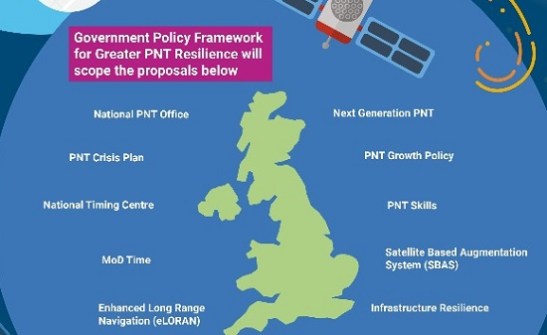
While the Australian geospatial sector still awaits the publication of the nation’s official positioning, navigation and timing (PNT) roadmap, the United Kingdom Government is showing the way by releasing a strategy for ensuring the continuity of PNT services in the UK.
The ten-point plan includes establishing a National PNT Office and a National Timing Centre, having back-up plans in the event of disruption to the GNSS, along with various other initiatives such as terrestrial timing networks and precision clock research to boost resilience and reduce risk.
The aim is the ensure critical sectors such as finance, defence, transportation, telecommunications and emergency services, as well as everyday services such as banking and the stock market, are protected from failure in the event of major problems with the current PNT system.
The new strategy — which the UK Government is describing as a “framework” — was released on 18 October by the UK’s Science Minister, George Freeman.
“Position, navigation and timing is vital to so many of the public services we rely on daily — from the emergency services to transport, satellites and telecommunications,” said Minister Freeman.
“Enhancing our PNT resilience and long-term capabilities is key to both Critical National Infrastructure, our economic security and resilience and strategic high growth sectors like space, future telecoms, quantum and cyber security.
“Today’s policy framework, including the creation of our new National PNT Office, is a sign of our commitment to PNT as a key strategic capability.”
The ten elements of the framework are:
- Establish a National PNT Office in the Department of Science, Innovation and Technology, with responsibility for PNT policy, coordination and delivery.
- Retain and update a cross-government PNT Crisis Plan to be activated if GNSS-provided PNT is lost, and identify and implement short-term mitigations.
- Develop a proposal for a National Timing Centre to provide resilient, terrestrial, sovereign and high-quality timing for the National Physical Laboratory (NPL) time scale (known as UTC(NPL)), including sovereign components and optical clocks.
- Develop a proposal for a ‘Ministry of Defence Time’ with the aim of creating deeper resilience through a system of last resort, and use National Timing Centre-provided timing to support the Ministry of Defence.
- Develop a proposal for a resilient, terrestrial and sovereign Enhanced Long-Range Navigation (eLORAN) system to provide back-up positioning and navigation.
- For infrastructure resilience, roll out resilient GNSS receiver chips, develop holdover clocks and consider options for legislation on critical national infrastructure sectors to require minimum-resilient PNT.
- Develop a proposal for a UK Precise Point Positioning Satellite-Based Augmentation System (SBAS) to replace the use of the European Geostationary Navigation Overlay Service, monitor GNSS and enable GNSS-dependent, high-accuracy positioning for autonomous and precision uses.
- Improve sector-wide skills by exploring options for Centres for Doctoral Training in timing and PNT, and review PNT skills, education and training for long-term sovereign PNT capability.
- Develop a PNT growth policy, including R&D program, standards and testing, to drive innovation for PNT-based productivity.
- Develop next-generation PNT by deploying existing R&D funding into a UK Quantum Navigator and investigate possible options for a sovereign UK regional satellite system.
As a sign of the importance to the community of the largely unseen PNT sector, the UK government has also published a report showing the economic impact if the GNSS were to be disrupted — a 24-hour outage could result in a £1.4 billion loss to the UK economy, with a seven-day outage causing a loss of £7.6 billion.
The report, which is a re-evaluation of an analysis from 2017, showed that most of the economic losses during a seven-day outage would result from disruption to emergency services and road and maritime transport, collectively making up 87.5% of the total losses.
Coinciding with the release of the PNT plan, was the publication of the Space Based PNT Technical Concepts report from the UK Space Agency, which looks at a range of ways of delivering PNT services from space and will serve as a foundation for the decision-making process of the new PNT Office as it contemplates future space-based PNT solutions.
Robust and resilient PNT
The announcement of the new PNT strategy has met with approval from a range of UK stakeholders.
“I am very pleased to see the publication of a cross-government PNT policy framework to develop the capabilities, skills and technologies that will ensure our future PNT Resilience. This framework will provide ever-increasing opportunities for economic growth, employment and innovation for the UK,” said Professor Dame Angela McLean, the Government Chief Scientific Adviser.
“PNT resilience was identified as a significant issue in the 2018 Blackett Report, Satellite-derived Time and Position: A Study of Critical Dependencies — this policy framework will help address the challenges set out there.”

John Pottle, Director of the Royal Institute of Navigation, described it as a “significant and very welcome announcement” that “recognises that achieving greater PNT resilience is a multi-faceted endeavour”.
“The ownership provided by the National PNT Office will provide policy and delivery oversight, and co-ordination across all stakeholders,” he said. “As well as improving national preparedness, the PNT framework has potential to help further strengthen the UK’s thought leadership and innovation in robust and resilient PNT.”
David Henderson, Chief Geospatial Officer at Ordnance Survey pointed out that “With new technology-enabled ecosystems like autonomous vehicles and digital twins starting to take shape, it’s the perfect time to be thinking in a strategic way about how we use and develop our position, navigation and timing systems”.
“We have the infrastructure and know-how in the UK to help us think innovatively about how to better connect our digital and physical places, and the PNT framework sets out a clear way of thinking of how we can strengthen that,” he added.
On the specific topic of timing, Dr Peter Thompson, CEO of the UK’s National Physical Laboratory (NPL), said that “The inclusion of a commitment to develop a proposal for a National Timing Centre in the new government policy framework for greater PNT resilience is an important step to improving timing resilience for UK critical infrastructure and the wider economy”.
A UK National Timing Centre research and development program was announced in early 2020 and is led by the NPL in partnership with others, including Innovate UK.
“The NPL, as the home of accurate time in the UK and the national technical authority for time and frequency, will continue to work with DSIT on the challenge of timing resilience, building on the ongoing National Timing Centre R&D programme,” added Dr Thompson.
PNT for national security
The UK has been looking into the problem of assured PNT for some time now. The new framework builds on prior work such as the 2018 Satellite-derived Time and Position: A Study of Critical Dependencies report and the UK Space Agency’s Space Based PNT Programme (SBPP), which had been established to investigate alternatives for the delivery of PNT services from space. An earlier effort had even considered the possibility of the UK developing its own conventional GNSS, similar to GPS or Galileo.
In addition, the 2021 Integrated Review of Security, Defence, Development and Foreign Policy included a commitment to beef up the resilience of the PNT services on which the country’s critical national infrastructure and economy depend. It also follows the inclusion of the potential loss of PNT services in the 2023 National Risk Register, the public version of the National Security Risk Assessment, which is described as the UK Government’s assessment of the most serious risks facing that country.
At the end of the last financial year, the UK Department for Science, Innovation and Technology re-allocated £14 million of existing funding to the National Physical Laboratory’s National Timing Centre Research and Development program, which will now conclude in March 2025. This program is described as ‘a key building block’ for the development a National Timing Centre.












